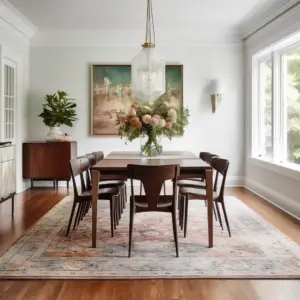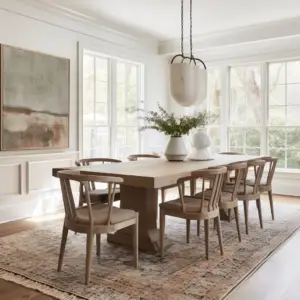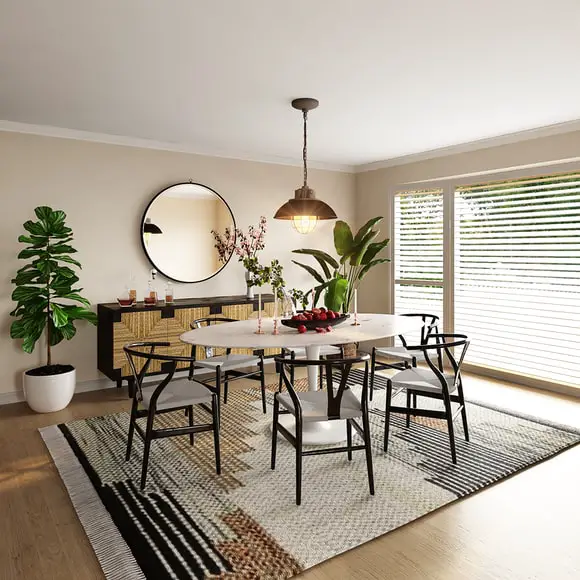Finding a dining room rug that’s both stylish and practical can be a little tricky; too large and may seem as if you’re trying to hide the floor; too small and it might imply you’re trying to conceal a stain. How big should a dining room rug be?
A fluffy pile can awkwardly shut in every crumb from the table, whereas too small rugs would trip up chairs. However, a decent rug size can provide warmth, color, and style to your dining room. Below are a few guidelines to help you achieve a great design statement in your dining room.
Table of Contents
How Big Should A Dining Room Rug Be? The Perfect Size

As a general rule, a dining room rug should have at least 24 inches of extra room on all sides of the dining table. The rug should sit directly under the dining table and be centered in the room to make the space feel balanced. This will allow enough space for guests to pull out chairs without tripping over the rug.
To make sure you’re getting the right size rug, measure your dining table and add 24-30 inches on each side. Mark the area directly on the floor with painter’s tape to see how it looks before you purchase the rug. The dining chairs should sit completely on the rug, with ample room to pull the chairs out and still remain on the rug.
Note that the rug should not be oversized that it covers your entire dining room. Check that you have at least 6-18 inches of floor showing all the way around the room. This will define your ding space and supporting furnishings.
Some people suggest that you measure your table with the leaves in and then add 24-30 inches for the right rug size. Although it’s acceptable, you might want to consider how often you’ll be using the leaves, and how adequate and comfortable your dining room is except for thanksgiving and big get-together (s).
The Perfect Size
That said, if you have the room, go ahead and take the measurements with the leaves in. The majority of people chose to measure the table without the leaves and the rugs still fits very comfortably. If you choose to measure the rug without leaves in, we recommend that use the higher end of the measurement spectrum.
The rug should be sufficiently big enough. Most rugs are rectangular, suitable for standard dining room tables, but there’re other varied options like an 8-foot or 10-foot square rug that fits most square tables.
As you think through the options and best measurements for your room, take into account any china cabinets and sideboards in the room. The rug in question should not extend beneath those dining room pieces.
Choose a Flat Weave or Short Pile Rug
Spills are inevitable. Thus, the ease with which you can pull a chair back is important. Low-pile or flatweave rugs are the practical choices in the dining room. Shag rugs, Moroccan carpets, and such thick fluffy rugs should be left in the dining room, where cleaning and maintenance are less required.
Consider the Rug as a Jumping-Off Point for Decorating
If you’re buying the rug as the first item for the dining room, you may consider using it to set the tone for the space and create a color scheme. For instance, you can pull the background or the lightest color from the rug and use it as the wall color. You can also develop a bolder hue from the rug as an accent in the room, artwork, or on chairs.
Choose the Right Pattern and Material
Usually, pure natural fibers like wool and cotton are the simplest to clean indoors whereas synthetic blends are the most difficult. The exceptions are stain-resistant rugs that are typically made to withstand scrubbing.
Experts usually recommend that you choose the rug first and then complement and style your room around it. However, if you already have all your furnishings, you can change up a more classic orientation rug from the ones that are a little more sophisticated and modern.
Look for a rug that features the colors in your room and opt for a larger geometric pattern that would not compete with the shades/patterns that are already in your dining room.
As mentioned above, a rug can set the tone for the whole room. Consider as art that goes on the floor- otherwise changing it can make a huge difference in the whole appearance of your dining room.
With a budget price tag, classic look, and great texture, natural fiber rugs contain sisal, jute, and seagrass, which makes them an easy recommendation. Meanwhile, where natural fibers like wool and cotton tend to be easy to clean, these natural materials can prove to be trickier.
The texture of the rug is the crux of the matter- the finer and smoother it is, the easier it’s likely to be to clean. On the flip side, it can be nearly impractical to remove ground-in food from nubby natural fiber rugs.
Matching the Rug Shape to Room Shape

If you have a square dining room, try a square/round rug. Rectangular rooms usually go well with rectangular rugs. Matching the shape of the room with your rug delivers a pleasing feeling of order to a space.
Matching Rug Shape to Table Shape
Round dining tables often look great with round or square rugs. Oval and rectangular dining tables usually work well with rectangular rugs. Likewise, square dining tables tend to work best with square rugs- even though round rugs could still work for a more playful feel.
Avoid Light Hues
Unless you’re planning to use the dining room more as a workspace than for dining parties, it’s best to keep off from light-colored rugs in this space. As beautiful as they are, a pale hue will easily show dirt and spots sooner than deeper, richer colors.
Carpet Tiles
Interlocking carpet squares can be incorporated in whatever size and shape you need. Plus, they come in a wide range of hues, textures, and patterns. One impressive thing that makes them suitable for dining rooms is that when a stain sets into one square, you can always replace it without buying a whole new rug.


